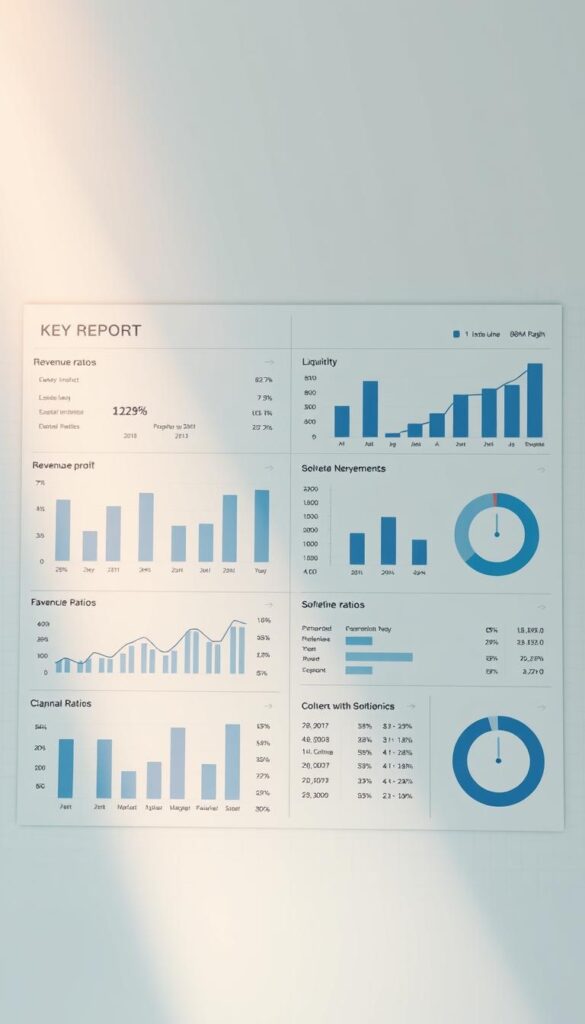Ever wondered why some businesses do well while others struggle? It’s all about knowing how to read financial statements. Learning to understand the balance sheet, profit and loss (P&L) statement, and cash flow statement is key. These documents offer deep insights into a company’s financial health and performance.
They are the most valuable source of financial information. They help you make sense of reports filled with confusing terms.
In today’s world, knowing about finances is more important than ever. Many small business owners worry about a long-term recession. Learning to check a company’s liquidity, profitability, and cash flow can help you make better investment choices and grow strategically. In this section, you’ll learn about the structure of these statements and how they work together to give you a full financial picture. So, let’s start and uncover the secrets behind financial reports!
Key Takeaways
- Financial statements are vital for understanding a company’s financial health.
- The three key financial statements are the Balance Sheet, P&L, and Cash Flow Statement.
- Analyzing these documents helps identify trends and make informed decisions.
- Financial literacy is essential, even in uncertain economic times.
- Knowing how to interpret ratios and performance metrics gives you an edge.
- Understanding the connection between these statements boosts your financial analysis skills.
Understanding Financial Statements
Financial statements are key for checking a company’s money situation and how it’s doing. They help us see important business money details. The main ones are the income statement, balance sheet, and cash flow statement. Each one shows different things and covers different time periods.
What are Financial Statements?
Financial statements show a company’s money health. The income statement shows sales, costs, and profit over time. It tells us how well a company makes money.
The balance sheet gives a quick look at a company’s money situation at one time. It lists assets, debts, and what the owners own. The cash flow statement shows money coming in and going out. It shows how well a company handles its money.
Importance of Financial Statements in Business
Financial statements are very important. They help everyone make smart choices. Investors and experts use them to see if a company is making money, if it can pay its debts, and if it’s growing.
By looking at these reports, leaders can spot money trends, keep costs down, and see risks. This helps them make better plans and improve how the business does. Knowing about financial statements helps us understand complex data and predict the future.
What is a Balance Sheet?
A balance sheet is a key financial statement. It shows a company’s financial state at a certain time. It lists the company’s assets, liabilities, and owners’ equity. This helps people understand the company’s financial health.
Knowing about balance sheets is important. It helps investors and managers see if a company is stable and performing well.
Components of a Balance Sheet
The balance sheet has three main parts:
- Assets: These are things the company owns, like cash, inventory, and buildings. Assets can be current, meaning they’ll be turned into cash in a year, or non-current, lasting longer.
- Liabilities: These are debts the company owes to others. Current liabilities are due in a year, while long-term liabilities are due later.
- Owners’ Equity: This shows what’s left of the company’s assets after paying off debts. It shows the owners’ share and is found by subtracting liabilities from assets.
Analyzing Assets, Liabilities, and Equity
Looking at assets, liabilities, and equity helps understand a company’s health. The accounting equation—Assets = Liabilities + Owners’ Equity—is key. It makes sure the balance sheet balances, showing resources are financed right.
Good analysis shows important numbers, like how liquid and solvent a company is. Walmart’s financials are a good example. They show how assets and liabilities work together. Knowing about balance sheets helps make smart choices for investments and running a business.

How to Read Financial Statements Like a Pro (Balance Sheet, P&L, and Cash Flow)
It’s key to understand how financial statements work together. When you learn to read them, see how the balance sheet, income statement, and cash flow statement link. Each statement gives a different view of a company’s financial health.
Looking at them all together helps you get a deeper understanding. You can spot trends and make better decisions.
Connecting the Three Key Financial Statements
The balance sheet shows what a company owns and owes at a certain time. It’s a snapshot of the company’s financial state. This is important for seeing how much a company has versus what it owes.
The income statement shows how profitable a company is over time. It lists revenue and expenses. This tells you if the business is making money or losing it.
For example, Microsoft made $245.1 billion in total revenue for the year ending June 30, 2023. This shows its strong market position and success. It also shows how well the company manages its costs.
The cash flow statement shows how money moves in and out of the company. This is important because a company can have high revenues but not enough cash. Analysts say a strong operating income can help improve cash flow for more investments.
Looking at these documents together gives a full picture of a company’s finances. A good income statement and a strong balance sheet show a company is doing well. Understanding these connections helps you analyze a company’s finances better and plan for the future.
Decoding the Income Statement (P&L)
The income statement, also known as the Profit and Loss Statement, is key for checking a business’s financial health. It shows how much money a company makes and spends over a certain time. By looking at the income statement, you can see how well a company is doing.
Key Components of an Income Statement
Your income statement has three main parts:
- Revenues: This shows the total money made from sales before any costs are taken out.
- Expenses: This includes costs for running the business, like what it costs to make and sell products and other expenses.
- Profit or Loss: The last line shows how much money is left after subtracting all expenses from all revenues.
Looking at each part helps understand a business’s financial health. For example, Apple made $365.7 billion in revenue for 2021, a 36% jump from the year before. This big increase shows how important it is to track revenue.
Understanding Revenue and Expenses
Looking at revenue and expenses together gives a clearer picture of a company’s profit. Revenue affects many financial decisions, while expenses show how well a business runs. For instance, Tesla’s Cost of Goods Sold in 2020 was $23.6 billion, making up 75% of its revenue. This shows the need to manage product costs well.
In real life, you can see how gross profit margin and net profit margin relate. Apple’s gross profit margin was 35.2% in 2021, down from 38.2% the year before. Changes like this can point to ways to make more profit or cut costs.

Analyzing Cash Flow Statements
The cash flow statement shows how a company uses and gets cash over time. It’s key to understanding how a business funds its day-to-day and growth plans. It breaks down into three parts: Cash Flow Operations, Investments, and Financing. Each part shows different cash management aspects.
Purpose of a Cash Flow Statement
The main job of a cash flow statement is to show cash coming in and going out. This helps people see if a company can pay its bills and grow. By looking at this statement, you can see if a company makes enough cash from its main activities or needs outside help.
Cash Flow Operations, Investments, and Financing
Cash Flow Operations (CFO) shows cash from regular business activities. For example, Company A made $53.66 billion from operations last year. Investing activities show cash spent on assets or business chances, which was $33.77 billion for Company A. Financing activities show cash flows with owners and creditors, with Company A spending $16.3 billion.
| Category | Amount (in billions) |
|---|---|
| Beginning Cash Balance | $10.75 |
| Cash Flow from Operations | $53.66 |
| Cash Used in Investing Activities | ($33.77) |
| Cash Used in Financing Activities | ($16.3) |
| Net Increase in Cash | $3.51 |
| Ending Cash Balance | $14.26 |
Looking at all parts, the company ended the year with more cash. This shows good management of its resources. Understanding these flows helps in making smart investment choices and checking if a business can keep going.

Key Financial Metrics to Monitor
It’s key to know the financial metrics of a company to see how it’s doing. By looking at these metrics, you can learn a lot about how well a business is running. Financial ratios are great tools for this, helping you understand things like liquidity and profitability.
Keeping an eye on these metrics helps make sure everything is running smoothly. It also helps make smart decisions for the future.
Common Financial Ratios
There are several important financial ratios to know. These include:
- Current Ratio: This ratio checks if a company can pay off short-term debts with its short-term assets.
- Quick Ratio: A tighter measure of liquidity that doesn’t count inventory.
- Debt to Equity Ratio (D/E): Shows how much debt a company has compared to its own funds.
- Net Profit Margin: This shows what percentage of revenue turns into profit after all costs.
- Return on Equity (ROE): Measures how well a company uses shareholders’ money to make profits.
Using Ratios for Financial Analysis
Using ratios for analysis gives a full picture of a company’s finances. For instance, the current ratio and quick ratio help figure out if a company is liquid. The debt-to-equity ratio shows how much debt a company has compared to its equity.
Each ratio offers a unique view of a company’s financial health. Plus, comparing these ratios to industry standards can spot any financial trouble.

| Financial Ratio | Formula | Purpose |
|---|---|---|
| Current Ratio | Current Assets / Current Liabilities | Measures liquidity and short-term financial health. |
| Quick Ratio | (Current Assets – Inventories) / Current Liabilities | Assesses quick liquidity by removing inventory from assets. |
| Debt to Equity Ratio | Total Liabilities / Shareholder Equity | Indicates the balance between debt financing and equity financing. |
| Net Profit Margin | Net Income / Revenue | Shows how much profit is generated from revenues. |
| Return on Equity (ROE) | Net Income / Shareholders’ Equity | Measures the return on investment for shareholders. |
How to Spot Trends in Financial Data
Understanding financial data is key for smart business decisions. Spotting trends involves looking at year-over-year changes and comparing to industry standards. This helps you see how your business is growing and working over time.
Analyzing Year-Over-Year Performance
Year-over-year analysis shows growth patterns and seasonal changes. By comparing financial metrics from year to year, you can see if your business is getting better or facing issues. Important metrics include:
- Gross Profit Margin: Sees how much profit is kept from each dollar earned.
- Net Profit Margin: Shows profit after all costs are paid.
- Current Ratio: Checks if you can meet short-term debts.
If your gross profit margin keeps going up, it means your operations are efficient. Aiming for a 10% revenue growth each year is a sign of good health.
Comparative Analysis with Industry Benchmarks
Comparing to industry benchmarks helps you see how competitive you are. Metrics like the quick ratio and debt-to-equity ratio should match industry averages.
| Financial Metric | Your Business | Industry Benchmark |
|---|---|---|
| Current Ratio | 3.27:1 | Minimum: 2:1 |
| Quick Ratio | 2.18:1 | Minimum: 1:1 |
| Debt to Equity Ratio | 0.4:1 | Maximum: 4:1 |
This comparison shows where you might need to improve or invest. For example, a high current ratio means you manage assets well. Checking these metrics often keeps your finances strong and lets you adjust your plans.

Building Your Financial Analysis Skills
Improving your financial analysis skills is key, whether you run a business, manage a team, or dream of a finance career. There are many resources to boost your financial literacy, like online courses, workshops, and tutorials. These tools help you make smart financial choices.
Resources for Financial Literacy
To grow your financial knowledge, check out these resources:
- Online courses on platforms like Coursera and Udemy
- Workshops at local community colleges on basic finance
- Tutorials and webinars by certified financial experts
Using these Financial Literacy Resources can greatly help you build your financial analysis skills.
Practical Tips for Reading Financial Statements
To get better at reading financial statements, try these tips:
- Learn key financial terms to understand better.
- Keep up with financial statements to spot trends and changes.
- Use ratio analysis to link different financial numbers.
- Seek advice from financial pros for deeper insights and practical examples.
By following these Tips for Reading Financial Statements, you’ll understand financial data better. Regular practice and working with financial documents will improve your decision-making skills.

Conclusion
Mastering financial analysis means understanding the three main financial statements. These are the income statement, balance sheet, and cash flow statement. Each gives important insights into a company’s financial health.
The income statement shows how much money a company makes and spends. It tells you if they made a profit or lost money. The balance sheet, on the other hand, gives a snapshot of what a company owns, owes, and is worth at a certain time.
Learning how these statements work together is key. The cash flow statement shows how cash moves in and out of a company. This helps you see if a company can pay its bills. Knowing this is essential for making smart decisions.
As you get better at financial analysis, using ratios and spotting trends will help you a lot. These skills improve your understanding of financial statements. They also help you predict what might happen in the future.
By mastering financial analysis, you can handle the challenges of the business world. This puts you in a strong position for long-term success.
FAQ
What are the three main financial statements I should be familiar with?
Why is it important to analyze financial statements?
What is the significance of the balance sheet?
How do the income statement and cash flow statement differ?
What key financial metrics should I monitor?
How can I spot trends in financial data?
What resources can help me improve my financial analysis skills?
What practical tips can help me read financial statements effectively?
Source Links
- Guide to Financial Statements – Capital City Training Ltd – https://www.capitalcitytraining.com/knowledge/financial-statement-guide/
- Reading Financial Statements: Types, Analysis & Step-by-Step Guide – https://www.highradius.com/resources/Blog/how-to-read-different-financial-statements-guide/
- What are the three financial statements? – https://www.cubesoftware.com/blog/three-financial-statements
- Three Financial Statements – https://corporatefinanceinstitute.com/resources/accounting/three-financial-statements/
- How to Read Financial Statements: A Comprehensive Guide – https://ecombalance.com/how-to-read-financial-statements/
- Financial Statements: How to Read and Understand Them – https://synder.com/blog/how-to-read-and-understand-financial-statements/
- How to Read Financial Statements: A Beginner’s Guide – https://online.hbs.edu/blog/post/how-to-read-financial-statements
- How Do You Read a Balance Sheet? – https://www.investopedia.com/articles/04/031004.asp
- Understanding Financial Statements: The Balance Sheet, Income Statement and Cash Flow Statement – https://www.score.org/resource/article/understanding-financial-statements-balance-sheet-income-statement-and-cash-flow
- Income Statement: How to Read and Use It – https://www.investopedia.com/terms/i/incomestatement.asp
- 3 Financial Statements to Measure a Company’s Strength – https://www.schwab.com/learn/story/3-financial-statements-to-measure-companys-strength
- Cash Flow Statement: Explanation and Example | Bench Accounting – https://www.bench.co/blog/accounting/cash-flow-statements
- Decoding Income Statement: Your Ultimate Guide to Understanding Profit and Loss – https://www.peakframeworks.com/post/income-statement
- Microsoft PowerPoint – Basic Understanding of a Company’s Financials -PWC-2.pptx – https://www.pwc.com/jm/en/research-publications/pdf/basic-understanding-of-a-companys-financials.pdf
- Make More Money by Mastering Your P&L Statements | Entrepreneur – https://www.entrepreneur.com/money-finance/what-exactly-is-your-income-statement-telling-you/288146
- How to Read & Understand a Cash Flow Statement | HBS Online – https://online.hbs.edu/blog/post/how-to-read-a-cash-flow-statement
- How are the Three Financial Statements Linked? – https://www.wallstreetprep.com/knowledge/how-are-the-financial-statements-linked/
- Analyzing Financial Statements: Key Metrics and Methods – https://corporatefinanceinstitute.com/resources/accounting/analysis-of-financial-statements/
- 10 metrics to analyze a company’s financial performance – https://ramp.com/blog/how-to-measure-company-financial-performance
- How to read financial statements – https://www.business.govt.nz/business-performance/strategic-finance/how-to-read-financial-statements
- How to Read (and Analyze) Financial Statements | Bench Accounting – https://www.bench.co/blog/accounting/how-to-read-and-analyze-financial-statements
- How to Read and Understand Your Financial Statements Like a Pro: A Guide for Business Owners – https://acceta-fintech.com/blog/how-to-read-and-understand-your-financial-statements-like-a-pro–a-guide-for-business-owners
- Financial Statement Analysis: How It’s Done, by Statement Type – https://www.investopedia.com/terms/f/financial-statement-analysis.asp
- 4 Financial Analysis Skills All Managers Need | HBS Online – https://online.hbs.edu/blog/post/financial-analysis-skills